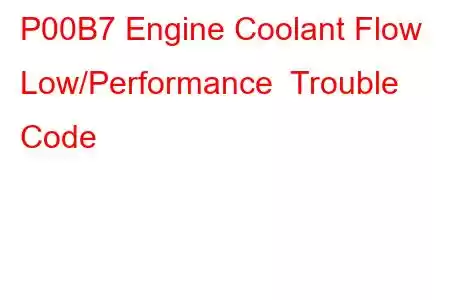P00B7 Engine Coolant Flow Low/Performance
OBD-II Trouble Code Technical Description
Engine Coolant Flow Low/Performance
What does that mean?
This generic powertrain diagnostic trouble code (DTC) typically applies to many OBD-II vehicles. That may include but is not limited to vehicles from Chevy, Audi, Ford, VW, etc. Anecdotally this particular code seems to be more commonly found on Chevrolet / Chevy vehicles (Sonic, Aveo, Malibu, Spark, etc.).
Anytime that I have been faced with diagnosing a code P00B7, it has meant that the powertrain control module (PCM) had detected a discrepancy in the correlating signals between the radiator coolant temperature sensor and the engine coolant temperature (ECT) sensor. This may cause the PCM to reach the conclusion that engine coolanat flow is restricted.
In order to make sure that coolant is flowing as intended between the radiator and the engine cooling passages, coolant temperature in the radiator is sometimes monitored in comparison with the temperature of coolant in the engine.
An example of an engine coolant temperature sensor:
ECT sensor design usually consists of a thermal resistor that is dipped in a hard resin and sealed in a metal or plastic housing. Brass is the most popular of these housing materials because of its durability. In most cases, the ECT sensor is threaded so that it may be screwed into a coolant passage in the engine intake manifold, cylinder head, or block. The level of thermal resistance in the ECT sensor decreases as coolant warms and flows across it. This leads to increased ECT sensor circuit voltage at the PCM. As the engine cools, sensor resistance increases and ECT sensor circuit voltage (to the PCM) is reduced as a result. The PCM recognizes these fluctuations in voltage as changes in engine coolant temperature. Fuel delivery and ignition timing strategy are among the functions affected by actual engine coolant temperature and input data from the ECT sensor.
The radiator coolant temperature sensor monitors coolant temperature in much the same manner as the ECT sensor. It is typically inserted into one of the radiator tanks but may also be fitted into a pressurized coolant reservoir.
If the PCM detects voltage signals from the ECT sensor and the radiator coolant temperature sensor which differ from one another by greater than the maximum allowable parameter, a code P00B7 will be stored and a malfunction indicator lamp (MIL) may be illuminated. Multiple drive cycles with a failure may be required for MIL illumination.
What is the severity of this DTC?
As ECT sensor input is critical to fuel delivery and ignition timing strategy, the conditions that contribute to a stored code P00B7 should be addressed with urgency.
What are some of the symptoms of the code?
Symptoms of a P00B7 engine code may include:
Excessively rich exhaust Drivability issues Poor idle quality Seriously diminished fuel efficiencyWhat are some of the common causes of the code?
Causes for this engine code may include:
Low coolant Stuck thermostat Defective ECT sensor Faulty radiator coolant temperature sensor Shorted or open circuits or connectors Bad PCM or PCM programming errorWhat are some P00B7 troubleshooting steps?
An effort should be made to ensure that the engine is full of coolant and not overheating before attempting to diagnose any stored ECT sensor related codes. Before proceeding, the engine must be full of the proper coolant and not overheating under any circumstances. Cold cranking the engine and allowing the thermostat to open (while observing the temperature gauge or scanner data display) is also a good idea.
A source of reliable vehicle information, a diagnostic scanner, a digital volt/ohmmeter (DVOM), and an infrared thermometer with a laser pointer will be required to diagnose a code P00B7.
<Read: 47


